When Fire Systems Go Silent
In the early hours of October 6, 2025, tragedy unfolded at Jaipur’s Sawai Man Singh (SMS) Hospital, where a fire in the trauma care building led to multiple fatalities. Within minutes, thick smoke engulfed the ICU and nearby wards — patients were trapped, and staff fled amid chaos.
Families of victims have claimed that the fire alarm didn’t ring, sprinklers didn’t activate, and even fire extinguishers were empty. The hospital reportedly had only one fireman and a helper on duty that night — a shocking lapse in preparedness for a public medical facility.
This isn’t an isolated case. It’s part of a long pattern where active fire protection systems fail at the moment they’re most needed. When alarms remain silent and sprinklers stay dry, what remains is not fire safety — it’s an illusion.
The Fragile Trust in Active Fire Protection
Most buildings in India are equipped with active systems: fire alarms, extinguishers, and sprinklers. On paper, this creates a reassuring image of safety. But in reality, these systems depend on maintenance, calibration, and human vigilance — all of which are routinely neglected.
A single sensor fault, power cut, or untested valve can render the entire system useless. And when that happens in critical facilities like hospitals, the consequences are instant and irreversible.
Fire doesn’t wait for a signal. Smoke travels faster than people can respond. That’s why every structure must combine active and passive fire protection — one to detect and suppress, the other to contain and delay.
The Neglected Half: Passive Fire Protection
Passive Fire Protection (PFP) isn’t about gadgets — it’s about resilience. It includes fire-resistant coatings on steel structures, firestop sealants and mortars around ducts and cables, and fire barriers that compartmentalize fire and smoke.
While active systems aim to fight the fire, passive systems aim to slow it, maintaining structural stability long enough for evacuation and rescue.
Standards like NBC 2016 Part 4, BS 476 Parts 20 & 21, and IS 1641–1646 mandate that key structural elements resist fire for at least two to four hours, depending on occupancy and risk category. Yet, most buildings — even hospitals — skip this crucial layer of protection during construction to save cost or due to lack of enforcement.
If Ameetuff Systems Were in Place
Had Ameetuff’s fire-resistant coatings and sealants been applied, the Jaipur fire would likely have been contained within the storage room itself. Our intumescent mortar coating would have choked the fire at its origin, while fire-stop sealants around ducts and cable entries would have sealed smoke pathways, preventing it from spreading into patient areas. In short, flames would have been trapped — not lives.
Conclusion
The Jaipur SMS Hospital fire isn’t just another headline — it’s a warning that our dependence on active systems alone is unsustainable. Fire alarms may fail. Sprinklers may stall. But passive fire protection stands guard even when everything else collapses.
Until India treats passive fireproofing with the same urgency as alarms and extinguishers, we’ll keep mistaking compliance certificates for safety.
(Sources: NDTV / Inshorts, October 6, 2025; Indian Express – “Patients Dead After Fire at Jaipur SMS Hospital”


